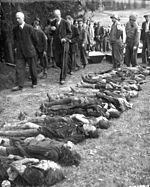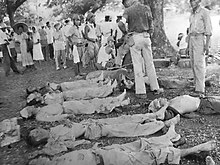Death march: Difference between revisions
Reverted good faith edits by 84.215.167.170 (talk). (TW) |
No edit summary |
||
| Line 5: | Line 5: | ||
== Examples of death marches == |
== Examples of death marches == |
||
* As part of Indian Removal in the United States, in 1831, around 6000 Choctaw left Mississippi for Oklahoma, and around only 4000 arrived in 1832.<ref>http://www.choctawnation.com/history/choctaw-nation-history/trail-of-tears/</ref> |
* As part of [[Indian removal|Indian Removal in the United States]], in 1831, around 6000 Choctaw left Mississippi for Oklahoma, and around only 4000 arrived in 1832.<ref>http://www.choctawnation.com/history/choctaw-nation-history/trail-of-tears/</ref> |
||
*In 1836, after the Creek War, 2,500 Muskogee were deported from Alabama by the United States Army in chains as prisoners of War.<ref>http://www.digitalhistory.uh.edu/database/article_display.cfm?HHID=638; see also Grant Foreman. Indian Removal: The Emigration of the Five Civilized Tribes of Indians. University of Oklahoma Press: 1974 [1932]</ref> The rest of the tribe (12,000) followed, being deported by the Army. Upon arrival in Oklahoma, 3,500 died of infection.<ref>http://www.everyculture.com/multi/Bu-Dr/Creeks.html#b</ref> |
*In 1836, after the Creek War, 2,500 Muskogee were deported from Alabama by the United States Army in chains as prisoners of War.<ref>http://www.digitalhistory.uh.edu/database/article_display.cfm?HHID=638; see also Grant Foreman. Indian Removal: The Emigration of the Five Civilized Tribes of Indians. University of Oklahoma Press: 1974 [1932]</ref> The rest of the tribe (12,000) followed, being deported by the Army. Upon arrival in Oklahoma, 3,500 died of infection.<ref>http://www.everyculture.com/multi/Bu-Dr/Creeks.html#b</ref> |
||
Revision as of 01:15, 10 October 2013
A death march is a forced march of prisoners of war or other captives or deportees with the intent to kill, brutalize, weaken and/or demoralize as many of the captives as possible along the way. It is distinguished in this way from simple prisoner transport via foot march. Death marches usually consist of harsh physical labor and abuse, neglect of prisoner injury and illness, deliberate starvation and dehydration, humiliation and torture, and execution of those who are unable to keep up the marching pace. The march may end at a prisoner of war camp or internment camp, or it may continue until all the prisoners are dead (a form of "execution by labor", as seen in the Armenian genocide among other examples). The signing of the Geneva Convention made death marches a form of war crime.
Examples of death marches
- As part of Indian Removal in the United States, in 1831, around 6000 Choctaw left Mississippi for Oklahoma, and around only 4000 arrived in 1832.[1]
- In 1836, after the Creek War, 2,500 Muskogee were deported from Alabama by the United States Army in chains as prisoners of War.[2] The rest of the tribe (12,000) followed, being deported by the Army. Upon arrival in Oklahoma, 3,500 died of infection.[3]
- In 1838, the Cherokee nation had to march westward towards Oklahoma. This death march became known as the Trail of Tears where an estimated 4,000 men, women, and children died during relocation.[4]
- During the years 1914-1923, large numbers of Ottoman Greeks were subjected to death marches, in series of events that became known as the Greek genocide.
- During the 1915 Armenian Genocide, hundreds of thousands of men, women and children were forced to march through the desert of Deir ez-Zor to the Deir ez-Zor Camps where most of them perished. Today there is a memorial in Deir ez-Zor for the marchers.
Second world war

- The term 'death march' was used in the context of the World War II history by victims and then by historians to refer to the forcible movement between fall 1944 and April 1945 by Nazi Germany of thousands of prisoners, mostly Jews, from Nazi concentration camps near the advancing war front to camps inside Germany.
An infamous one occurred in January 1945, as the Soviet Red Army advanced on occupied Poland. Nine days before the Soviets arrived at the death camp at Auschwitz, the SS marched nearly 60,000 prisoners out of the camp toward Wodzisław Śląski (German: Loslau), 35 miles away, where they were put on freight trains to other camps. Approximately 15,000 prisoners died on the way.[5][6]

- In the Pacific Theatre, the Imperial Japanese Army conducted death marches, including the infamous Bataan Death March (1942) and Sandakan Death Marches (1945).
- During the 1948 Arab-Israeli war, some 70,000 Palestinian Arabs from the cities of Al-Ramla and Lydda were forcibly expelled by Israeli forces. The event has come to be known as the Lydda Death March.[7]
- In the Korean War of winter 1951, 200,000 South Korean National Defense Corps soldiers were forcibly marched by their commanders, and 90,000 soldiers starved to death or died of disease by their commanders embezzlement.[8] This incident is known as National Defense Corps Incident.
- The 1975 forced evacuation of Phnom Penh in Cambodia under the Khmer Rouge.
See also
References
- ^ http://www.choctawnation.com/history/choctaw-nation-history/trail-of-tears/
- ^ http://www.digitalhistory.uh.edu/database/article_display.cfm?HHID=638; see also Grant Foreman. Indian Removal: The Emigration of the Five Civilized Tribes of Indians. University of Oklahoma Press: 1974 [1932]
- ^ http://www.everyculture.com/multi/Bu-Dr/Creeks.html#b
- ^ Marshall, Ian (1998). Story line: exploring the literature of the Appalachian Trail (Illustrated ed.). University of Virginia Press. ISBN 978-0-8139-1798-6.
- ^ [http://www.ushmm.org/outreach/dmarch.htm "Death marches", United States Holocaust Memorial Museum.
- ^ Martin Gilbert (May 199). Atlas of the Holocaust (map of forced marches). William Morrow & Company. ISBN 0688123643.
{{cite book}}: Check date values in:|date=(help) - ^ Holmes, Richard; Strachan, Hew; Bellamy, Chris; Bicheno, Hugh (2001). The Oxford companion to military history (Illustrated ed.). Oxford University Press. p. 64. ISBN 9780198662099.
On 12 July, the Arab inhabitants of the Lydda-Ramle area, amounting to some 70,000, were expelled in what became known as the 'Lydda Death March'.
- ^ Terence Roehrig (2001). Prosecution of Former Military Leaders in Newly Democratic Nations: The Cases of Argentina, Greece, and South Korea. McFarland & Company. p. 139. ISBN 978-0-7864-1091-0.
{{cite book}}: Cite has empty unknown parameter:|coauthors=(help)
